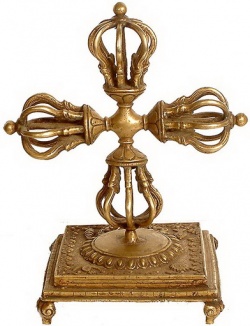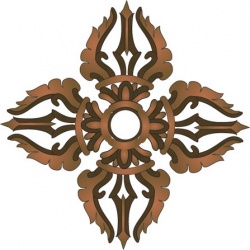Visvavajra
Before time began, there was only darkness and the emptiness that is the Void. A gentle wind arose from the four directions that, over time, filled the Void. It began to grow in power until, after eons had passed, the wind coalesced into a substance so thick, so heavy, so solid, so immutable that it formed Dorje Gyatram, the vajra cross that is the basis of the physical universe.
Also known as the double dorje (visvavajra) this powerful symbol is also associated with Amogasiddhi (Tibetan: Donyo drupa), who is the Karma family buddha. His name means Unfailing Accomplishment. His activity transmutes the klesha (stain, or imperfection) of jealousy. His activity is the subtle one of diminishing attachment. He is green in color, his left hand rests in his lap in the mudra of equanimity and his right at chest level palm outwards in the "granting protection" or "not to fear" gesture. His consort is Damtsig Dolma, Green Tara.
The vajra cross, whether vertical or in X-form, is also considered an emblem of protection.
The vishvavajra, (vishwa or vishva is Sanskrit for world with the connotation of "theuniverse as we experience it," and it means the double dorje or crossed dorjes. It stands for the stability or foundation of the physical world. This is a mark often used as a seal or stamp and may be found impressed or incised on the plate at the base of a statue that protects and keeps prayers/relics inside. It is also the emblem of Buddhist deities whose influence encourages immoveable determination. The Visva Vajra is a protective symbol that dispels evil, temptation and deception from the four directions, dispels ignorance and invites wisdom, boosting power. The double Vajra is fitted into the Shri Yantra. A most potent and indestructible symbol.
Source
The viswa vajra is created by two crossed vajras or four vajra-heads that sit at the cardinal points of a central hub. Vajra is a Sanskrit word that means both thunderbolt and diamond. As a ritual object in Buddhism, the vajra symbolises the indestructibility of a diamond and the irresistible force of the thunderbolt. The crossed, double or universal vajra is thus called the viswa vajra and represents the absolute stability of the physical world. It is also a powerful protective symbol that cannot be destroyed but itself destroys all evil. It is associated with Amogasiddhi, one of the five Dhyani Buddhas whose mudra is Granting Protection or Fearlessness (hand raised with outward facing palm) and whose consort is the Green Tara.
With its dual meaning of stability and protection from evil, deception and temptation, the viswa vajra is utilised extensively in Buddhism in its two dimensional and three dimensional forms. It is often found stamped or applied to the base plate of statues that have been consecrated, and to canisters and containers that hold precious relics, important documents or prayers. It can be worn as a pendant to provide spiritual protection. In visualisation practices associated with the teaching and learning of Buddhist principles, the viswa vajra may be imagined by the practitioner to assist with stabilising the mind, creating a receptive state in which ignorance is dispelled and wisdom is encouraged, thereby increasing spiritual power.
References and Further Reading
- Beer, Robert 2003 The Handbook of Tibetan Buddhist Symbols. Serindia Publications, Inc.
- Chinese Buddhist Encyclopedia. Visvavajra. Accessed 9 May 2017
- Wikipedia. Vajra. Accessed 9 May 2017

